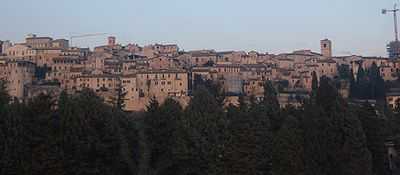Spello
| Spello | ||
|---|---|---|
| Comune | ||
| Comune di Spello | ||
 | ||
| ||
 Spello | ||
| Coordinates: 42°59′N 12°40′E / 42.983°N 12.667°ECoordinates: 42°59′N 12°40′E / 42.983°N 12.667°E | ||
| Country | Italy | |
| Region | Umbria | |
| Province | Perugia (PG) | |
| Frazioni | Collepino, San Giovanni, Limiti, Acquatino, Capitan Loreto | |
| Government | ||
| • Mayor | Sandro Vitali (since June 13, 2004) | |
| Area | ||
| • Total | 61 km2 (24 sq mi) | |
| Elevation | 280 m (920 ft) | |
| Population (2007) | ||
| • Total | 8,585 | |
| • Density | 140/km2 (360/sq mi) | |
| Demonym | Spellani | |
| Time zone | CET (UTC+1) | |
| • Summer (DST) | CEST (UTC+2) | |
| Postal code | 06038 | |
| Dialing code | 0742 | |
| Patron saint | St. Felix | |
| Saint day | May 18 | |
| Website | Official website | |
Spello (in Antiquity: Hispellum) is an ancient town and comune (township) of Italy, in the province of Perugia in east central Umbria, on the lower southern flank of Mt. Subasio. It is 6 km (4 mi) NNW of Foligno and 10 km (6 mi) SSE of Assisi.
The old walled town lies on a regularly NW-SE sloping ridge that eventually meets the plain. From the top of the ridge, Spello commands a good view of the Umbrian plain towards Perugia; at the bottom of the ridge, the town spills out of its walls into a small modern section (or Borgo) served by the rail line from Rome to Florence via Perugia.


History
Populated in ancient times by the Umbri, it became a Roman colony in the 1st century BC. Under the reign of Constantine the Great it was called Flavia Constans, as attested by a document preserved in the local Communal Palace.
Main sights
The densely-inhabited town, built of stone, is of decidedly medieval aspect, and is enclosed in a circuit of medieval walls on Roman foundations, including three Roman Late Antique gates (Porta Consolare, Porta di Venere and the "Arch of Augustus") and traces of three more, remains of an amphitheater, as well several medieval gates. Spello boasts about two dozen small churches, most of them medieval: the most important are:
- Santa Maria Maggiore (known from 1159), probably built over an ancient temple dedicated to Juno and Vesta. The façade has a Romanesque portal and a 13th-century bell tower, while the pilasters next to the apse have frescoes by Perugino (1512). The most striking feature is the Baglioni Chapel, frescoed by Pinturicchio. The Umbrian artist was called to paint it around 1500 by Troilo Baglioni, after he had just finished the Borgia Apartment's decoration. The cycle include the Annunciation, the Nativity and the Dispute with the Doctors, plus four Sibyls in the vault. The Palazzo dei Canonici, annexed to the church, houses the Town's Art Gallery.
- Sant'Andrea (known from 1025). The interior, on a single nave, has 14th-century frescoes. There's also a panel by Pinturicchio.
- San Lorenzo (12th century). San Bernardino da Siena began his preaching season in this church in 1438.
- San Claudio (11th century or earlier), an elegant example of Romanesque architecture with a rose window on the asymmetrical façade. The interior has 14th century votive frescoes from the Umbrian school. It is said to have been built on the remains of a Paleo-Christian cemetery.
- Tega Chapel (14th century), with Umbrian school 15th-century frescoes, including a Crucifixion attributed to Nicolò Alunno.
Other points of interest include:
- Palazzo Comunale Vecchio ("Old Town Hall", built in 1270 and enlarged after the end of the Baglioni seigniory, in 1567-1575). It has some frescoed halls, one attributed to the Zuccari brothers. It is faced by a 16th-century fountain.
- Palazzo Cruciali, built in the early 17th century.
- Palazzo Baglioni, erected as a fortificated mansion around 1359. The Governor's Hall has frescoes from the 16th century.
- Arch of Augustus (1st century BC-1st century AD).
In the plain, near S. Claudio, are the remains of a semi-excavated Roman amphitheater; and a small valley to the east of the town is remarkable for its traces of Roman centuriation.
Beyond the town proper, the comune's chief monuments are the church of San Silvestro at Collepino, and the church of the Madonna della Spella with late-medieval votive frescoes and graffiti.
Festivals
- The Infiorate include a whole night of work to create over sixty flower carpets on the Corpus Domini feast.
Twin towns
 Alfonsine, Italy, since 1974
Alfonsine, Italy, since 1974
Since 2008 Spello has also a pact of friendship with Accadia, Italy.
Photo gallery
-

View of the town
-

Infiorata 2004
-

Infiorata 2006
External links
| Wikimedia Commons has media related to Spello. |
- Official site
- Bill Thayer's site (including Urbini's Spello, Bevagna, Montefalco)
- Creative Spello by Adalberto Tiburzi
